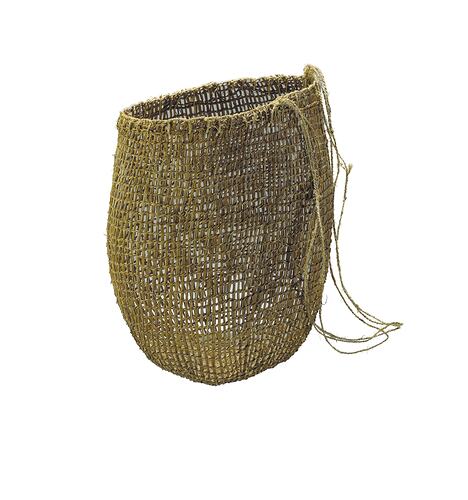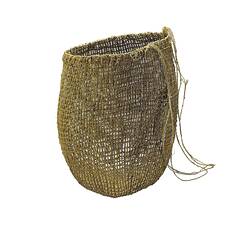Summary
This basket demonstrates the continuation of traditional cultural practices among Indigenous Australian people. Prior to European settlement almost all older Aboriginal women would have been basket makers and certain men also practised this specialised craft, particularly for making fish traps. Today Aboriginal women across Australia continue to pass on their skills, with Arnhem Land having the greatest number of skilled weavers, and the sale of their work is an important source of income. In Arnhem Land, conical baskets such as this are known as hunting bags. Being made from the tall sedge grass (Cyperus javanicus or Cyperus conicus) that is harvested after the beginning of the rainy season, gives their structure strength, and were made in a variety of sizes and used for a range of purposes, including carrying heavy loads of game, fish and vegetable matter. In camp, they were hung from forked sticks to keep meat and fish away from dogs. Smaller versions were used as sieves for straining food and placed in running water to leach poisons from bush foods. They are rarely decorated and their open weave allows sand, dirt and other matter such as blood and water to drain off. Miwana is the name for sedge grass itself, but is the term that can also refer to sedge grass baskets.
Local Name
miwanna
Physical Description
A twined conical basket made of sedge grass with an open weave. The multi-strand handle made of vegetable fibre string is attached to the basket at the back.
More Information
-
Object/Medium
Basket
-
Maker
-
Locality
Maningrida, Eastern Arnhem Land, Northern Territory, Australia
-
Date Produced
-
Collector
-
Date Collected
-
Object Measurements
310 mm (Length), 170 mm (Width), 210 mm (Height)
-
Keywords
-
References
[Book] Museum Victoria. 2004. Treasures of the Museum. Victoria, Australia. 206.
-
Collection Names
-
Type of item
-
Discipline
-
Category
-
Collecting Areas
Australian Indigenous - Northern Australia and Queensland and Torres Strait Islands, Australian Indigenous Identity and Contemporary Life


